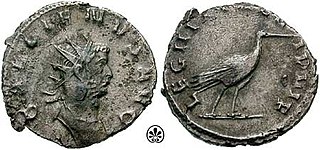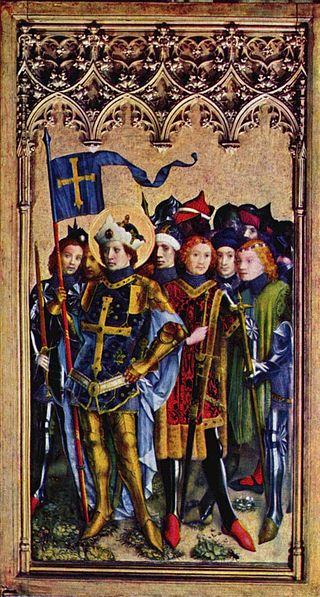
Legio VIII Augusta was one of the oldest legions of the Imperial Roman army.

Legio III Italica was a legion of the Imperial Roman army founded in 165 AD by the emperor Marcus Aurelius for his campaign against the Marcomanni tribe. The cognomen Italica suggests that the legion's original recruits were drawn for the defence of Italy. The legion was still active in Raetia and other provinces in the early 5th century.
Legio III Parthica was a legion of the Imperial Roman army founded in AD 197 by the emperor Septimius Severus for his campaign against the Parthian Empire, hence the cognomen Parthica. The legion was still active in the Eastern provinces in the early 5th century. The legion's symbol was probably a bull.

The Jovians and Herculians were the senior palatine imperial guard units under the rule of Roman Emperor Diocletian. They continued in existence thereafter as senior units in the field armies of the Western and Eastern Roman Empires.

The Theban Legion figures in Christian hagiography as a Roman legion from Egypt—"six thousand six hundred and sixty-six men"— Christians who were martyred together in 286, according to the hagiographies of Maurice, the chief among the Legion's saints. Their feast day is held on September 22.

Legio V Macedonica was a Roman legion. It was probably originally levied in 43 BC by consul Gaius Vibius Pansa Caetronianus and Gaius Iulius Caesar Octavianus. It was based in the Balkan provinces of Macedonia, Moesia and Dacia. In the Notitia Dignitatum records from beginning of the fifth century, the legion was still stationed in Dacia, with detachments stationed in the east and Egypt.

The Legio II Flavia Constantia was a comitatensis Roman legion, created by Diocletian or Galerius, probably in the years 293, 296 or 297.

Legio V Iovia was a Roman legion levied by Diocletian in the end of the 3rd century, and was still in service at the beginning of the 5th century. The cognomen of the legion refers to Jupiter, to whom Diocletian was devoted and identified.

Legio VI Herculia was a Roman legion levied by Diocletian in the end of the 3rd century, and was still in service at the beginning of the 5th century. The cognomen of the legion refers to Hercules, to whom Diocletian's colleague, Maximian, was devoted and identified.
Legio II Isaura was a pseudocomitatensis Roman legion, levied no later than under Diocletian, and possibly already present under Probus. As their name suggests, II Isaura and its twin legion III Isaura were guarding the Isauria territory at the time of the Notitia Dignitatum, to defend it from the incursions of the mountain peoples. It is possible that in the beginning they were supported by I Isaura Sagittaria. According to Ammianus Marcellinus, in 360, they were stationed in Bezabde with II Armeniaca, and II Parthica, when the king of Persia, Shapur II besieged and conquered the city, killing many of the inhabitants.

Legio I Isaura Sagitaria was a pseudocomitatensis Roman legion. The legion was probably created by emperor Probus. It is possible that in the beginning it, together with the II and III Isaura, it was used to defend the Isauria region, The legion campaigned against the tribes of Cilicia. As its name suggests, its legionaries could be used also as archers, an uncommon feature for Roman legions. According to Notitia Dignitatum, in the beginning of the 5th century the I Isaura was under the command of the Magister Militum per Orientem.

Legio III Diocletiana was a comitatensis Roman legion, levied in 296 by Diocletian, from whom the legion took its name. The aim of this unit was to guard the newly re-organized province of Aegyptus, being based in Alexandria. It was created to support II Traiana Fortis, and thus it took the numeral III.

Legio II Flavia Virtutis was a comitatensis Roman legion, levied by Emperor Constantius II (337–361), together with I Flavia Pacis and III Flavia Salutis.
Legio I Iovia was a Roman legion, levied by Emperor Diocletian (284–305), possibly together with II Herculia, to guard the newly created province of Scythia Minor. The cognomen of this legion came from Diocletian's attribute Iovianus, "similar to Jupiter". According to Notitia Dignitatum, at the beginning of the 5th century I Iovia was still in its camp on the Danube. The legion may have even survived the fall of Rome and continued to serve the Byzantine empire.
Legio II Herculia was a Roman legion, levied by Emperor Diocletian (284–305), possibly together with I Iovia, to guard the newly created province of Scythia Minor. It was stationed at Capidava. The cognomen of this legion came from Herculius, the attribute of Maximian meaning "similar to Hercules".

Legio I Armeniaca was a pseudocomitatensis legion of the Late Roman Empire. The Legio I Armeniaca was likely creatred in the late 4th century by either Julian the Apostate or Diocletian. It is possible that the name of the legion could mean that it was originally part of the garrison of the Armeniac provinces. This unit, together with its twin legion II Armeniaca, appears to have been included in the imperial field army. It was based in Bezabde until the Persians captured the area in 360. The Legio I Armeniaca took part in Julian's invasion of the Sassanid Empire. The Notitia dignitatum records the legion as being under the command of the magister militum per Orientis around 400.
Legio V Parthica was a legion of the Roman Empire garrisoned in Amida, Mesopotamia, established by the Roman emperor Diocletian (284–305), who reorganized the eastern frontier. The legion is described by the historian Ammianus Marcellinus. The cognomen "Parthica" was an archaism, as the Parthian Empire was already replaced by the Sasanian Empire at the time of the establishment of the legion.

Legio I Flavia Constantia was a Roman legion, mentioned in the Notitia Dignitatum as a comitatenses unit stationed in the Eastern Empire.
The Legio I Illyricorum was a Roman Legion stationed in Qasr el-Azraq and Palmyra; it is mentioned in the Notitia Dignitatum. According to many ancient sources, it was stationed within the Eastern Half of the Roman Empire, under emperor Aurelian.













